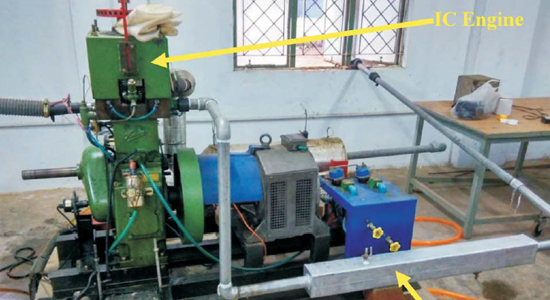Ragupathi This email address is being protected from spambots. You need JavaScript enabled to view it.1, Debabrata Barik2, G. Vignesh3, S. Aravind3
1Research Scholar, Department of Mechanical Engineering, Karpagam Academy of Higher Education, Coimbatore, India, 641021.
2Associate Professor, Department of Mechanical Engineering, Karpagam Academy of Higher Education, Coimbatore, India, 641021.
3Assistant Professor, Department of Mechanical Engineering, Karpagam Academy of Higher Education, Coimbatore, India, 641021.
REFERENCES
- [1] Tang Z. B., Y. D. Deng, C. Q. Su, W. W. Shuai, and C. J. Xie. "A research on thermoelectric generator's electrical performance under temperature mismatch conditions for automotive waste heat recovery system." Case Studies in Thermal Engineering 5 (2015): 143-150. DOI: 10.1016/j.csite.2015.03.006
- [2] Albadr, Jaafar, Satinder Tayal, and MushtaqAlasadi. "Heat transfer through heat exchanger using Al2O3nanofluid at different concentrations." Case Studies in Thermal Engineering 1, no. 1 (2013): 38-44. DOI: 10.1016/j.csite.2013.08.004
- [3] Khaled, Mahmoud, Mohamad Ramadan, Khaled Chahine, and Ali Assi. "Prototype implementation and experimental analysis of water heating using recovered waste heat of chimneys." Case Studies in Thermal Engineering 5 (2015): 127-133. DOI: 10.1016/j.csite.2015.03.004
- [4] Orr, B., A. Akbarzadeh, M. Mochizuki, and R. Singh. "A review of car waste heat recovery systems utilising thermoelectric generators and heat pipes." Applied Thermal Engineering 101 (2016): 490-495.
- [5] Remeli, Muhammad Fairuz, L. Kiatbodin, B. Singh, K. Verojporn, A. Date, and A. Akbarzadeh. "Power generation from waste heat using heat pipe and thermoelectric generator." Energy Procedia 75 (2015): 645-650. DOI: 10.1016/j.egypro.2015.07.477
- [6] Lan, Song, Zhijia Yang, Rui Chen, and Richard Stobart. "A dynamic model for thermoelectric generator applied to vehicle waste heat recovery." Applied energy 210 (2018): 327-338. DOI:10.1016/j.apenergy.2017.11.004
- [7] Aghaali H, Angstrom H-E. A review of turbocompounding as a waste heat recovery system for internal combustion engines. Renew Sustain Energy Rev (2015); 49:813-824. DOI: 10.1016/j.rser.2015.04.144
- [8] Yu S, Du Q, Diao H, Shu G, Jiao K. Start-up modes of thermoelectric generator based on vehicle exhaust waste heat recovery. Appl Energy (2015); 138:276-290. DOI: 10.1016/j.apenergy.2014.10.062
- [9] He W, Wang S, Yue L. High net power output analysis with changes in exhaust temperature in a thermoelectric generator system. Appl Energy (2017); 196:259–267. DOI: 10.1016/j.apenergy.2016.12.078
- [10] Aranguren P, Astrain D, Rodríguez A, Martínez A. Experimental investigation of the applicability of a thermoelectric generator to recover waste heat from a combustion chamber. Appl Energy (2015);152:121–30. DOI: 10.1016/j.apenergy.2015.04.077
- [11] Hsu C-T, Huang G-Y, Chu H-S, Yu B, Yao D-J.An effective Seebeck coefficient obtained by experimental results of a thermoelectric generator module.Appl Energy 2011;88(12):5173–5179. DOI: 10.1016/j.apenergy.2011.07.033
- [12] Pandiyarajan, V., M. Chinna Pandian, E. Malan, R. Velraj, and R. V. Seeniraj. "Experimental investigation on heat recovery from diesel engine exhaust using finned shell and tube heat exchanger and thermal storage system." Applied Energy 88, no. 1 (2011): 77-87. DOI: 10.1016/j.apenergy.2010.07.023
- [13] Remeli, Muhammad Fairuz, K. Verojporn, B. Singh, L. Kiatbodin, A. Date, and A. Akbarzadeh. "Passive heat recovery system using combination of heat pipe and thermoelectric generator." Energy Procedia 75 (2015): 608-614. DOI: 10.1016/j.egypro.2015.07.465
- [14] Ding, Lai Chet, Nathan Meyerheinrich, Lippong Tan, KawtarRahaoui, Ravi Jain, and AliakbarAkbarzadeh. "Thermoelectric power generation from waste heat of natural gas water heater." Energy Procedia 110 (2017): 32-37. DOI: 10.1016/j.egypro.2017.03.101
- [15] Maheswari, K. S., K. KalidasaMurugavel, and G. Esakkimuthu. "Thermal desalination using diesel engine exhaust waste heat—an experimental analysis." Desalination 358 (2015): 94-100. DOI: 10.1016/j.desal.2014.12.023
- [16] Rana, Sohel, Bradley Orr, Arbab Iqbal, Lai Chet Ding, AliakbarAkbarzadeh, and Abhijit Date. "Modelling and optimization of low-temperature waste heat thermoelectric generator system." Energy Procedia 110 (2017): 196-201.
- [17] LeBlanc, Saniya. "Thermoelectric generators: Linking material properties and systems engineering for waste heat recovery applications." Sustainable Materials and Technologies 1 (2014): 26-35. DOI: 10.1016/j.egypro.2017.03.127
- [18] Bradley Orr, and AliakbarAkbarzadeh. "Prospects of waste heat recovery and power generation using thermoelectric generators." Energy Procedia 110 (2017): 250-255. DOI: 10.1016/j.egypro.2017.03.135
- [19] D. Dai, Y. Zhou, J. Liu, Liquid metal based thermoelectric generation system for waste heat recovery. Renew. Energy 36 (2011) 3530–3536. DOI:10.1016/j.renene.2011.06.012
- [20] Q.E. Hussain, D.R. Brigham, C.W. Maranville, Thermoelectric exhaust heat recovery for hybrid vehicles, SAE Int. J. Engines 2 (2009) 1132–1142. DOI: 10.4271/2009-01-1327
- [21] N. Espinosa, M. Lazard, L. Aixala, H. Scherrer, Modeling a thermoelectric generator applied to diesel automotive heat recovery, J. Electron. Mater. 39 (2010) 1446–1455. DOI: 10.1007/s11664-010-1305-2
- [22] M. Mori, T. Yamagami, M. Sorazawa, T. Miyabe, S. Takahashi, T. Haraguchi, Simulation of fuel economy effectiveness of exhaust heat recovery system using thermoelectric generator in a series hybrid, SAE Int. J. Mater. Manuf. 4 (2011) 1268–1276.
- [23] C.T. Hsu, G.Y. Huang, H.S. Chu, B. Yu, D.J. Yao, Experiments and simulations onlow-temperature waste heat harvesting system by thermoelectric power generators, Appl. Energy 88 (2011) 1291–1297. DOI: 10.1016/j.apenergy.2010.10.005









